-
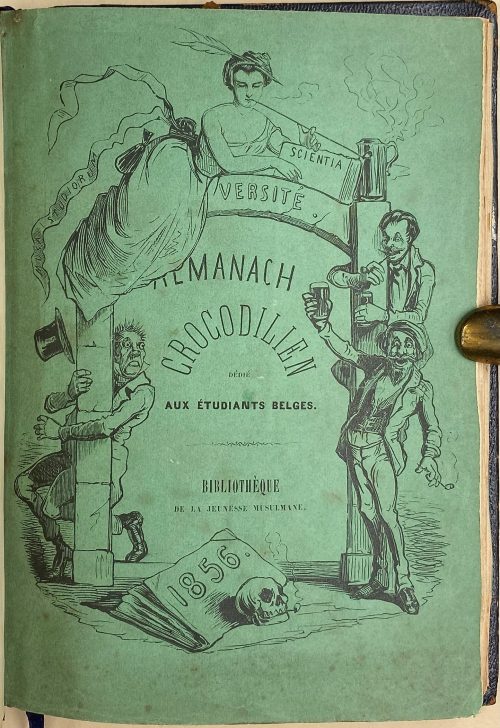 One volume collated 8vo, 19 x 14 cm, bound in black alligator leather. Front wrapper (green) / title-page (white): A female figure smoking a pipe next to a beer mug, reclining over an arch ring lettered “…VERSITÉ” (UNI… not shown), her dress ribbon lettered “MUSA STUDIORUM”, holding a book lettered “SCIENTIA”; within the arch « ALMANACH | CROCODILIEN | DÉDIÉ | AUX ÉTUDIANTS BELGES. | BIBLIOTHÈQUE | DE LA JEUNESSE MUSULMANE. »; below lies a book lettered “1856.”, next to it is a smoking skull; three male figures embracing the arch columns. Half-title: ALMANACH CROCODILIEN | POUR | L’ANNÉE BISSEXTILE, MAIS NÉANMOINS DE GRACE | 1856. || Pagination: [1-5] 6-14 [15-41] 42-134 [137] 138, total 136 pages within the wrappers, original publisher's green wrappers preserved, carte de visite ‘Félicien Rops, Étudiant’ and pink invitation card № 129 for ‘Bal des femmes’ on March 19, 1892 at ‘Fête annuelle du Courier Français’ bound in; in-text woodcuts, initials, head- and tail-pieces after Félicien Rops. Bookplate “Ex Libris Marcellus Schlimovich” with motto “Ars naturam adiuvat” on front pastedown. Stamp of the "Sociedad Hebraica Argentina / Coleccion M. Schlimovich / Varios / No. 2-492” to half-title. Pencil inscription to half-title: "Ex. Félicien Rops" – possibly an own copy of the artist. Collation: π2 1-88 92, total 68 leaves within wrappers. Printer: Typ. de J. Vanbuggenhoudt (Bruxelles). Sociedad Hebraica Argentina; Marcelo Schlimovich (Argentine-Jewish, ca. 1880 – 1960) – provenance. Félicien Rops (Belgian, 1833 – 1898) – artist.
One volume collated 8vo, 19 x 14 cm, bound in black alligator leather. Front wrapper (green) / title-page (white): A female figure smoking a pipe next to a beer mug, reclining over an arch ring lettered “…VERSITÉ” (UNI… not shown), her dress ribbon lettered “MUSA STUDIORUM”, holding a book lettered “SCIENTIA”; within the arch « ALMANACH | CROCODILIEN | DÉDIÉ | AUX ÉTUDIANTS BELGES. | BIBLIOTHÈQUE | DE LA JEUNESSE MUSULMANE. »; below lies a book lettered “1856.”, next to it is a smoking skull; three male figures embracing the arch columns. Half-title: ALMANACH CROCODILIEN | POUR | L’ANNÉE BISSEXTILE, MAIS NÉANMOINS DE GRACE | 1856. || Pagination: [1-5] 6-14 [15-41] 42-134 [137] 138, total 136 pages within the wrappers, original publisher's green wrappers preserved, carte de visite ‘Félicien Rops, Étudiant’ and pink invitation card № 129 for ‘Bal des femmes’ on March 19, 1892 at ‘Fête annuelle du Courier Français’ bound in; in-text woodcuts, initials, head- and tail-pieces after Félicien Rops. Bookplate “Ex Libris Marcellus Schlimovich” with motto “Ars naturam adiuvat” on front pastedown. Stamp of the "Sociedad Hebraica Argentina / Coleccion M. Schlimovich / Varios / No. 2-492” to half-title. Pencil inscription to half-title: "Ex. Félicien Rops" – possibly an own copy of the artist. Collation: π2 1-88 92, total 68 leaves within wrappers. Printer: Typ. de J. Vanbuggenhoudt (Bruxelles). Sociedad Hebraica Argentina; Marcelo Schlimovich (Argentine-Jewish, ca. 1880 – 1960) – provenance. Félicien Rops (Belgian, 1833 – 1898) – artist. -
 An uncut fan print showing Otsu-e [大津絵] (Otsu pictures). Artist: Utagawa Sadahide [歌川貞秀] (Japanese, 1807 – 1879). Signed: Gountei Sadahide ga [五雲亭貞秀画] (Picture by Gountei Sadahide); characters on the Otsu-e. Publisher: Ibaya Senzaburō [伊場屋仙三郎] (Japanese, c. 1815 – 1869). Published: c. 1849. Inscription in a paper-weight shaped cartouche: [大津追 分絵の図] Ōtsu-oi wake-e no zu (Following Otsu – image of separate pictures) No date seal, no censor seal (privately printed?) Media: Fan print (uchiwa-e, 団扇絵), 235 x 298 mm.
An uncut fan print showing Otsu-e [大津絵] (Otsu pictures). Artist: Utagawa Sadahide [歌川貞秀] (Japanese, 1807 – 1879). Signed: Gountei Sadahide ga [五雲亭貞秀画] (Picture by Gountei Sadahide); characters on the Otsu-e. Publisher: Ibaya Senzaburō [伊場屋仙三郎] (Japanese, c. 1815 – 1869). Published: c. 1849. Inscription in a paper-weight shaped cartouche: [大津追 分絵の図] Ōtsu-oi wake-e no zu (Following Otsu – image of separate pictures) No date seal, no censor seal (privately printed?) Media: Fan print (uchiwa-e, 団扇絵), 235 x 298 mm. -
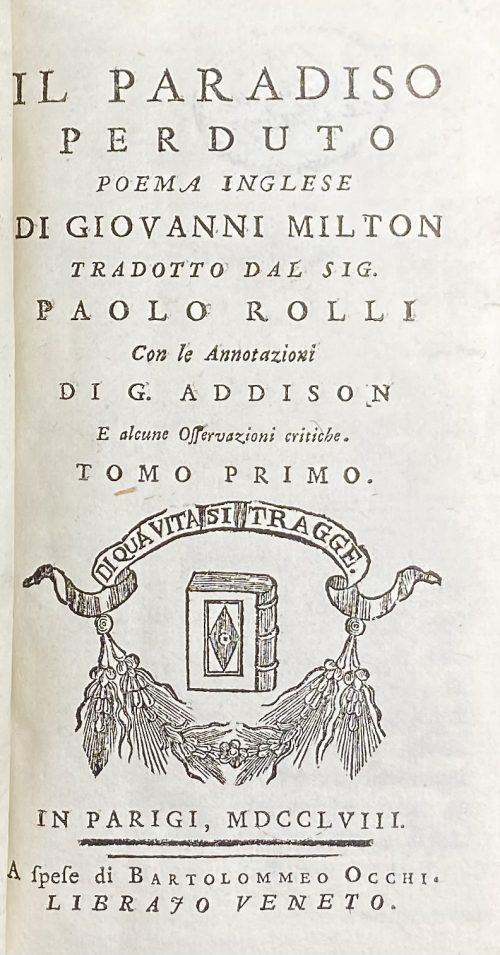 Quarter calf over marbled boards, 16 x 9 cm, spine with raised bands, gilt in compartments, gilt-lettered label, all margins red, two title-pages (one for each vol.), illustrated with engraved frontispiece by Antonio Baratti after Antonio Balestra; engraved portrait of John Milton by Antonio Baratti, 12 plates, one for each book, after “Piazzetta, Zucchi, Balestra, Tiepolo, and other Venetian artists”, unsigned; plate II signed ‘Antonio Barati scul.’ Title page: IL PARADISO | PERDUTO | POEMA INGLESE | DI GIOVANNI MILTON | TRADOTTO DAL SIG. | PAOLO ROLLI | Con le Annotazioni | DI G. ADDISON | E alcune Osservazioni critiche. | TOMO PRIMO (SECUNDO). | {publisher’s device} | IN PARIGI , MDCCLVIII. | — | A spese di Bartolommeo Occhi. | LIBRAJO VENETO. || Collation: *-**12 ***8 (dedication, vita), A-R12 (vol. 1) A-K12 L9 (vol.2); total 365 leaves plus 14 engraved plates, incl. frontispiece and portrait. Pagination: [i, ii] iii-lxiv 1-407 [408 blank], [2] 3-258; total 730 pages. Catalogue raisonné: Wickenheiser Collection 688 [LIB-2795.2021]. Though it states 228 pp., which does not seem right. “Scarce. Not in Coleridge”. Contributors: Milton, John (British, 1608 – 1674) – author. Joseph Addison (British, 1672 – 1719) – author / criticism Paolo Antonio Rolli (Italian, 1687 – 1765) – author / transaltion Bartolomeo Occhi (Italian, 1730 – 1781) – publisher. Antonio Baratti (Italian, 1724 – 1787) – engraver Antonio Balestra (Italian, 1666 – 1740) – artist. Giovanni Battista Piazzetta (Italian,1682/83 – 1754) – artist. Antonio Zucchi (Italian, 1726 – 1795) – artist. Giovanni Battista Tiepolo (Italian, 1696 – 1770) – artist.
Quarter calf over marbled boards, 16 x 9 cm, spine with raised bands, gilt in compartments, gilt-lettered label, all margins red, two title-pages (one for each vol.), illustrated with engraved frontispiece by Antonio Baratti after Antonio Balestra; engraved portrait of John Milton by Antonio Baratti, 12 plates, one for each book, after “Piazzetta, Zucchi, Balestra, Tiepolo, and other Venetian artists”, unsigned; plate II signed ‘Antonio Barati scul.’ Title page: IL PARADISO | PERDUTO | POEMA INGLESE | DI GIOVANNI MILTON | TRADOTTO DAL SIG. | PAOLO ROLLI | Con le Annotazioni | DI G. ADDISON | E alcune Osservazioni critiche. | TOMO PRIMO (SECUNDO). | {publisher’s device} | IN PARIGI , MDCCLVIII. | — | A spese di Bartolommeo Occhi. | LIBRAJO VENETO. || Collation: *-**12 ***8 (dedication, vita), A-R12 (vol. 1) A-K12 L9 (vol.2); total 365 leaves plus 14 engraved plates, incl. frontispiece and portrait. Pagination: [i, ii] iii-lxiv 1-407 [408 blank], [2] 3-258; total 730 pages. Catalogue raisonné: Wickenheiser Collection 688 [LIB-2795.2021]. Though it states 228 pp., which does not seem right. “Scarce. Not in Coleridge”. Contributors: Milton, John (British, 1608 – 1674) – author. Joseph Addison (British, 1672 – 1719) – author / criticism Paolo Antonio Rolli (Italian, 1687 – 1765) – author / transaltion Bartolomeo Occhi (Italian, 1730 – 1781) – publisher. Antonio Baratti (Italian, 1724 – 1787) – engraver Antonio Balestra (Italian, 1666 – 1740) – artist. Giovanni Battista Piazzetta (Italian,1682/83 – 1754) – artist. Antonio Zucchi (Italian, 1726 – 1795) – artist. Giovanni Battista Tiepolo (Italian, 1696 – 1770) – artist. -
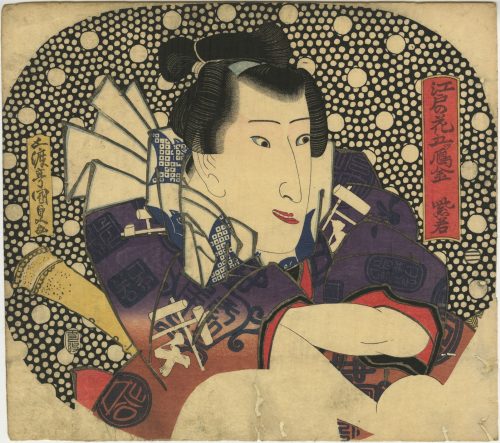 Artist: Utagawa Kunisada, a.k.a. Toyokuni III (Japanese, 1786 – 1865) [歌川 国貞]. Publisher: Ibaya Senzaburō [伊場屋仙三郎] (Japanese, fl. C. 1845 – 1847). Date aratame seal: Bunsei 12 (1829). Signed: Gototei Kunisada ga [五渡亭国貞画]. Media: Fan print (uchiwa-e), 238 x 267 mm (overtrimmed). Actor: Iwai Shijaku I [紫若] (Japanese, 1804 – 1845); other names: Iwai Matsunosuke I [岩井松之助]; Iwai Hanshirō VII, Iwai Shijaku I, Iwai Komurasaki I. The background is Arare-ko-mon [霰小紋] hail pattern. In the red cartouche at the top right is the series title "Edo no hana – itsutsu Karigane" (江戸の花 五雁金), to be translated as "Flowers of Edo - the five Karigane blood-brothers" (or "the five Karigane gang members"). Another print from the series in this collection: SVJP-0304.2019.
Artist: Utagawa Kunisada, a.k.a. Toyokuni III (Japanese, 1786 – 1865) [歌川 国貞]. Publisher: Ibaya Senzaburō [伊場屋仙三郎] (Japanese, fl. C. 1845 – 1847). Date aratame seal: Bunsei 12 (1829). Signed: Gototei Kunisada ga [五渡亭国貞画]. Media: Fan print (uchiwa-e), 238 x 267 mm (overtrimmed). Actor: Iwai Shijaku I [紫若] (Japanese, 1804 – 1845); other names: Iwai Matsunosuke I [岩井松之助]; Iwai Hanshirō VII, Iwai Shijaku I, Iwai Komurasaki I. The background is Arare-ko-mon [霰小紋] hail pattern. In the red cartouche at the top right is the series title "Edo no hana – itsutsu Karigane" (江戸の花 五雁金), to be translated as "Flowers of Edo - the five Karigane blood-brothers" (or "the five Karigane gang members"). Another print from the series in this collection: SVJP-0304.2019. -
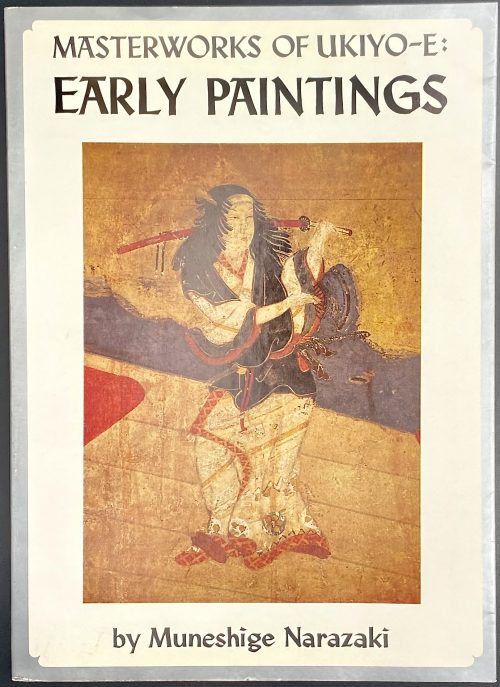 Paperback volume, 25.7 x 18.6 cm, brown embossed wrappers with framed Japanese characters along the outer margin, pictorial dust jacket with series design (black lettering and vignette in silver border to wrappers, black lettering on silver to spine); pp: [1-6]: h.t./frontis. (colour plate pasted in), t.p./imprint, contents/blank), 7-32 text, 33-96 (59 plates w/captions). Title-page (in frame): MASTERWORKS OF UKIYO-E | EARLY PAINTINGS | by Muneshige Narazaki | English adaptation by Charles A. Pomeroy | {publisher’s device} | KODANSHA INTERNATIONAL LTD. | Tokyo, Japan & Palo-Alto, Calif., U.S.A | {vertical between rules 初期 浮世絵} || Series: Masterworks of ukiyo-e, № 1. Contributors: Muneshige Narazaki [楢崎 宗重] (Japanese, 1904 – 2001) – author. Charles A. Pomeroy (American, b. 1930) – adaptation.
Paperback volume, 25.7 x 18.6 cm, brown embossed wrappers with framed Japanese characters along the outer margin, pictorial dust jacket with series design (black lettering and vignette in silver border to wrappers, black lettering on silver to spine); pp: [1-6]: h.t./frontis. (colour plate pasted in), t.p./imprint, contents/blank), 7-32 text, 33-96 (59 plates w/captions). Title-page (in frame): MASTERWORKS OF UKIYO-E | EARLY PAINTINGS | by Muneshige Narazaki | English adaptation by Charles A. Pomeroy | {publisher’s device} | KODANSHA INTERNATIONAL LTD. | Tokyo, Japan & Palo-Alto, Calif., U.S.A | {vertical between rules 初期 浮世絵} || Series: Masterworks of ukiyo-e, № 1. Contributors: Muneshige Narazaki [楢崎 宗重] (Japanese, 1904 – 2001) – author. Charles A. Pomeroy (American, b. 1930) – adaptation. -
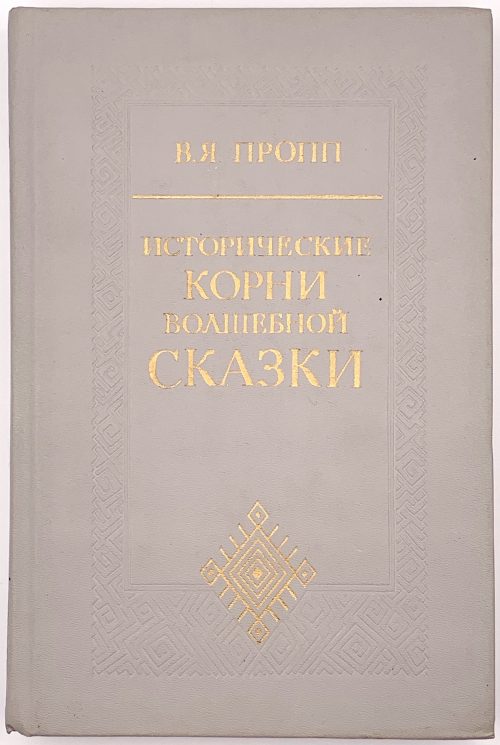 Hardcover volume, 22.2 x 14.8 cm, bound in grey buckram, gilt lettering in an ornamental frame to front and spine, blind-stamped lettering to back; pp.: [1-2] 3-364 [4], collated 8vo:1-238, total 184 leaves, 368 pages. Title-page: ЛЕНИНГАДСКИЙ ОРДЕНА ЛЕНИНА | И ОРДЕНА ТРУДОВОГО КРАСНОГО ЗНАМЕНИ | ГОСУДАРСТВЕННЫЙ УНИВЕРСИТЕТ ИМЕНИ А. А. ЖДАНОВА | {in two-compartment frame: В. Я. ПРОПП {within a compartment} | ИСТОРИЧЕСКИЕ КОРНИ ВОЛШЕБНОЙ СКАЗКИ {within a compartment} | ИЗДАТЕЛЬСТВО ЛЕНИНГРАДСКОГО УНИВЕРСИТЕТА | ЛЕНИНГРАД 1986 || Print run: 25,000 copies. Edition: 2nd edition; for the 1st edition, see [LIB-3184.2023] В. Я. Пропп. Исторические корни волшебной сказки. — Л.: ЛГУ, 1946. English title: [LIB-1615.2018] The historical roots of the fairy tale. Contributors: Владимир Яковлевич Пропп [Vladimir Propp] (Russian, 1895 – 1970)
Hardcover volume, 22.2 x 14.8 cm, bound in grey buckram, gilt lettering in an ornamental frame to front and spine, blind-stamped lettering to back; pp.: [1-2] 3-364 [4], collated 8vo:1-238, total 184 leaves, 368 pages. Title-page: ЛЕНИНГАДСКИЙ ОРДЕНА ЛЕНИНА | И ОРДЕНА ТРУДОВОГО КРАСНОГО ЗНАМЕНИ | ГОСУДАРСТВЕННЫЙ УНИВЕРСИТЕТ ИМЕНИ А. А. ЖДАНОВА | {in two-compartment frame: В. Я. ПРОПП {within a compartment} | ИСТОРИЧЕСКИЕ КОРНИ ВОЛШЕБНОЙ СКАЗКИ {within a compartment} | ИЗДАТЕЛЬСТВО ЛЕНИНГРАДСКОГО УНИВЕРСИТЕТА | ЛЕНИНГРАД 1986 || Print run: 25,000 copies. Edition: 2nd edition; for the 1st edition, see [LIB-3184.2023] В. Я. Пропп. Исторические корни волшебной сказки. — Л.: ЛГУ, 1946. English title: [LIB-1615.2018] The historical roots of the fairy tale. Contributors: Владимир Яковлевич Пропп [Vladimir Propp] (Russian, 1895 – 1970) -
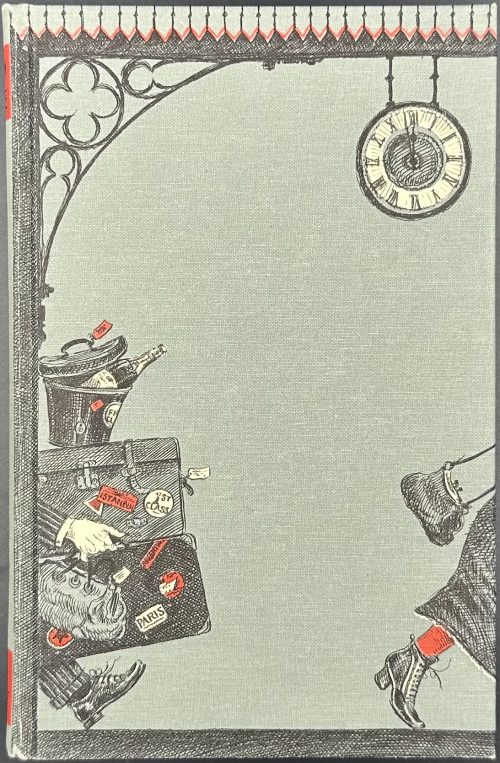 Hardcover volume, 23 x 15 cm, bound in full pictorial olive cloth, lettering to spine, in a green slipcase 23.5 x 15.9 cm; pp.: [1-4] 5- 267 [268] [4 blanks], b/w tailpieces, frontispiece and 8 colour photomechanical plates after John Holder. Title-page: GRAHAM GREENE | TRAVELS WITH MY AUNT | A Novel | Introduced by John Mortimer | Illustrated by John Holder | FOLIO SOCIETY | LONDON MMIV || Contributors: Graham Greene (British, 1904 – 1991) – author. John Mortimer (British, 1923 – 2009) – author/introduction. John Holder (British, b. 1941) – artist. St. Edmundsbury Press (UK) – printer. Hunter & Fouls (Haddington) – binder. Folio Society (UK) – publisher. For the 1st edition, see [LIB-2758.2021] Graham Greene. Travels with my aunt: a novel. — London: Bodley Head, 1969.
Hardcover volume, 23 x 15 cm, bound in full pictorial olive cloth, lettering to spine, in a green slipcase 23.5 x 15.9 cm; pp.: [1-4] 5- 267 [268] [4 blanks], b/w tailpieces, frontispiece and 8 colour photomechanical plates after John Holder. Title-page: GRAHAM GREENE | TRAVELS WITH MY AUNT | A Novel | Introduced by John Mortimer | Illustrated by John Holder | FOLIO SOCIETY | LONDON MMIV || Contributors: Graham Greene (British, 1904 – 1991) – author. John Mortimer (British, 1923 – 2009) – author/introduction. John Holder (British, b. 1941) – artist. St. Edmundsbury Press (UK) – printer. Hunter & Fouls (Haddington) – binder. Folio Society (UK) – publisher. For the 1st edition, see [LIB-2758.2021] Graham Greene. Travels with my aunt: a novel. — London: Bodley Head, 1969. -
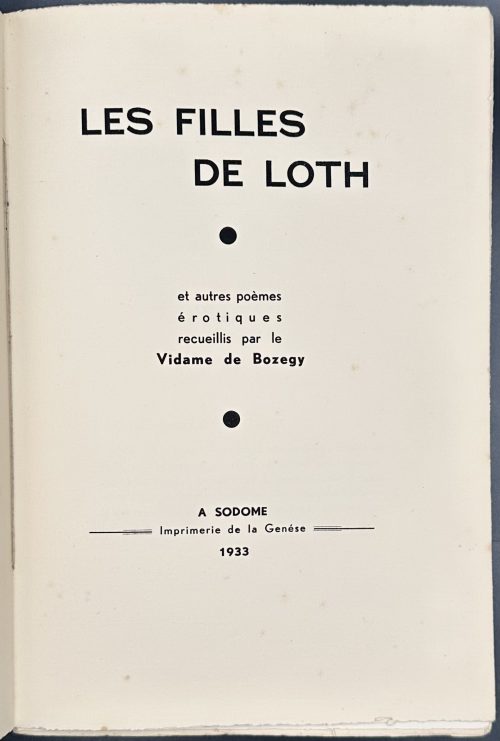 Softcover, french flapped wrappers, 29 x 19 cm, in glassine dustjacket, text printed on laid paper, pp.: [1-10] 11-256 [8], total 264 pages plus 11 plates out of 12, hand-coloured etchings on wove paper laid in, extraneous to collation. Wrappers detached from the block. Some pages uncut. Below is the missing plate, according to honesterotica.com:
Softcover, french flapped wrappers, 29 x 19 cm, in glassine dustjacket, text printed on laid paper, pp.: [1-10] 11-256 [8], total 264 pages plus 11 plates out of 12, hand-coloured etchings on wove paper laid in, extraneous to collation. Wrappers detached from the block. Some pages uncut. Below is the missing plate, according to honesterotica.com: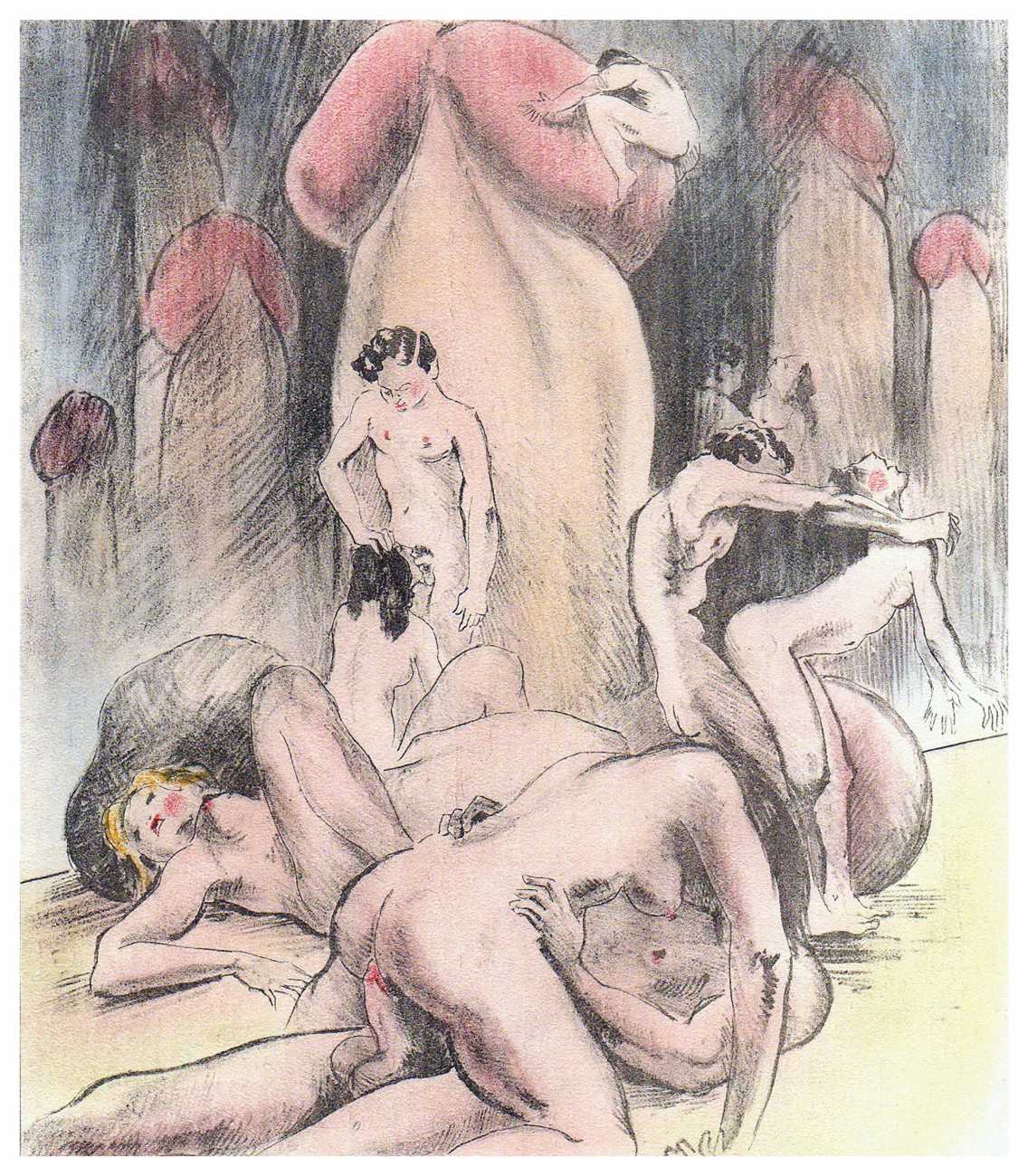 Title-page: LES FILLES | DE LOTH | • | et autres poèmes | érotiques | recueillis par le | Vidame de Bozegy | • | A SODOME | — Imprimerie de la Genèse — | 1933 ||
Edition limited to 500 copies, this is copy № 54.
Catalogue raisonné: Dutel III № 1575.
Edmond Dardenne Bernard [Vidame de Bozegy] (French, 20th c.) – author.
André Collot (French, 1897 – 1976) – artist.
Title-page: LES FILLES | DE LOTH | • | et autres poèmes | érotiques | recueillis par le | Vidame de Bozegy | • | A SODOME | — Imprimerie de la Genèse — | 1933 ||
Edition limited to 500 copies, this is copy № 54.
Catalogue raisonné: Dutel III № 1575.
Edmond Dardenne Bernard [Vidame de Bozegy] (French, 20th c.) – author.
André Collot (French, 1897 – 1976) – artist. -
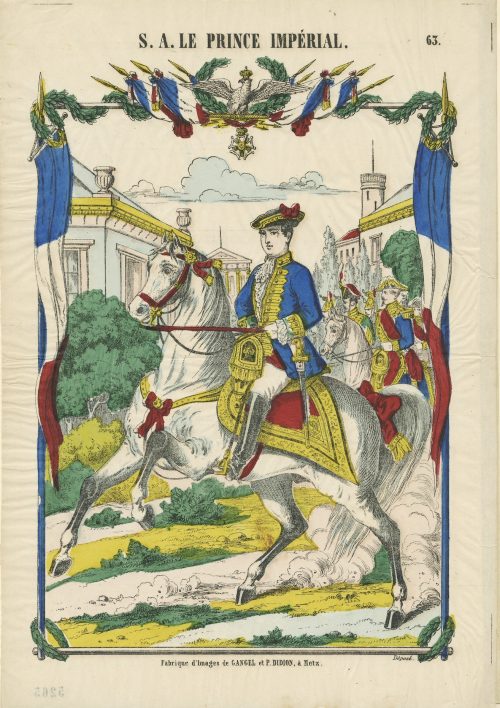 Hand-coloured woodcut on wove paper, 327 x 280 mm; black ink stamp “5265” to reverse, attached to the sheet 470 x 325 mm. Top centre: "S. A. LE PRINCE IMPÉRIAL.", right: "63." Image: equestiral portrait of Prince Impérial. Under the image, centre: "Fabrique d'Images de GANGEL et P. DIDION, à Metz." — "Déposé." Napoléon, Prince Imperial (Napoléon Eugène Louis Jean Joseph Bonaparte] (French, 1856 – 1879). Gangel et P. Didion (Metz); Paulin Didion (French, 1831 – 1879) – publisher/printer.
Hand-coloured woodcut on wove paper, 327 x 280 mm; black ink stamp “5265” to reverse, attached to the sheet 470 x 325 mm. Top centre: "S. A. LE PRINCE IMPÉRIAL.", right: "63." Image: equestiral portrait of Prince Impérial. Under the image, centre: "Fabrique d'Images de GANGEL et P. DIDION, à Metz." — "Déposé." Napoléon, Prince Imperial (Napoléon Eugène Louis Jean Joseph Bonaparte] (French, 1856 – 1879). Gangel et P. Didion (Metz); Paulin Didion (French, 1831 – 1879) – publisher/printer. -
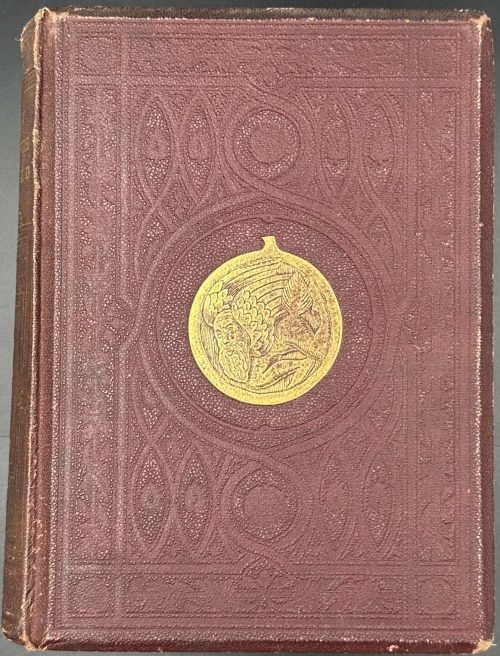 Hardcover, 23 x 17 x 4.7 cm, burgundy buckram, bevelled boards, blind geometrical design with a gilt medallion at the centre, gilt lettering and blind design elements to spine, text in frame, all edges red; pp.: [i-v] vi-xvi, [1] 2-494, [2 advert.], [1] 2-32 advert.], collation 4to: a-b4, B-3R4, a16. Title-page (red and black, in red frame): A HISTORY | OF | CARICATURE & GROTESQUE | {gothic letters} In Literature and Art. | By THOMAS WRIGHT, Esq., M.A., F.S.A., | Hon. M.R.S.L., &c.; | Corresponding Member of the Imperial Institute of France | (Académie des Inscriptions et Belles Lettres). |{double rules} | WITH | ILLUSTRATIONS FROM VARIOUS SOURCES, | DRAWN AND ENGRAVED BY | F. W. FAIRHOLT, Esq., F.S.A. | {double rules} | {gothic letters} London : | VIRTUE BROTHERS & CO., 1, AMEN CORNER, | PATERNOSTER ROW. | 1865. Contributors : Thomas Wright (British, 1792 – 1849) – author. Frederick William Fairholt (British, 1814 – 1866) – artist/engraver. Virtue Brothers & Co. (London) – publisher/printer.
Hardcover, 23 x 17 x 4.7 cm, burgundy buckram, bevelled boards, blind geometrical design with a gilt medallion at the centre, gilt lettering and blind design elements to spine, text in frame, all edges red; pp.: [i-v] vi-xvi, [1] 2-494, [2 advert.], [1] 2-32 advert.], collation 4to: a-b4, B-3R4, a16. Title-page (red and black, in red frame): A HISTORY | OF | CARICATURE & GROTESQUE | {gothic letters} In Literature and Art. | By THOMAS WRIGHT, Esq., M.A., F.S.A., | Hon. M.R.S.L., &c.; | Corresponding Member of the Imperial Institute of France | (Académie des Inscriptions et Belles Lettres). |{double rules} | WITH | ILLUSTRATIONS FROM VARIOUS SOURCES, | DRAWN AND ENGRAVED BY | F. W. FAIRHOLT, Esq., F.S.A. | {double rules} | {gothic letters} London : | VIRTUE BROTHERS & CO., 1, AMEN CORNER, | PATERNOSTER ROW. | 1865. Contributors : Thomas Wright (British, 1792 – 1849) – author. Frederick William Fairholt (British, 1814 – 1866) – artist/engraver. Virtue Brothers & Co. (London) – publisher/printer. -
 Iron tsuba of round form with design of two parallel crossbars and two rings in openwork (sukashi). Rounded square rim. Moderate iron bones (tekkotsu) allover. Copper sekigane. Kanayama school. Momoyama period (or late Muromachi). Size: 74.5 x 74.0 x 5.5 mm. The rings possibly represent the sun and the moon, or the stars. The parallel crossbars may represent the "two stripes" (futatsu biki) family crest (incl. Ashikaga family).
Iron tsuba of round form with design of two parallel crossbars and two rings in openwork (sukashi). Rounded square rim. Moderate iron bones (tekkotsu) allover. Copper sekigane. Kanayama school. Momoyama period (or late Muromachi). Size: 74.5 x 74.0 x 5.5 mm. The rings possibly represent the sun and the moon, or the stars. The parallel crossbars may represent the "two stripes" (futatsu biki) family crest (incl. Ashikaga family). -
 Signature: Unsigned
Signature: UnsignedFuchi-kashira with rock and boar (iwa ni inoshishi zu) motif. Inlay of precious stones or colour glass. Shakudō, gold, gemstones. Technique: Sukibori zogan kiniroe.
Fuchi: 36 x 21 x 14 mm; Weight: 22 g; Kashira: 32 x 17 x 5 mm; Weight: 8 g; Material : Shakudō; Gold; Gemstones (Chalcedony and Rose Quartz). Possibly, Owari school. -
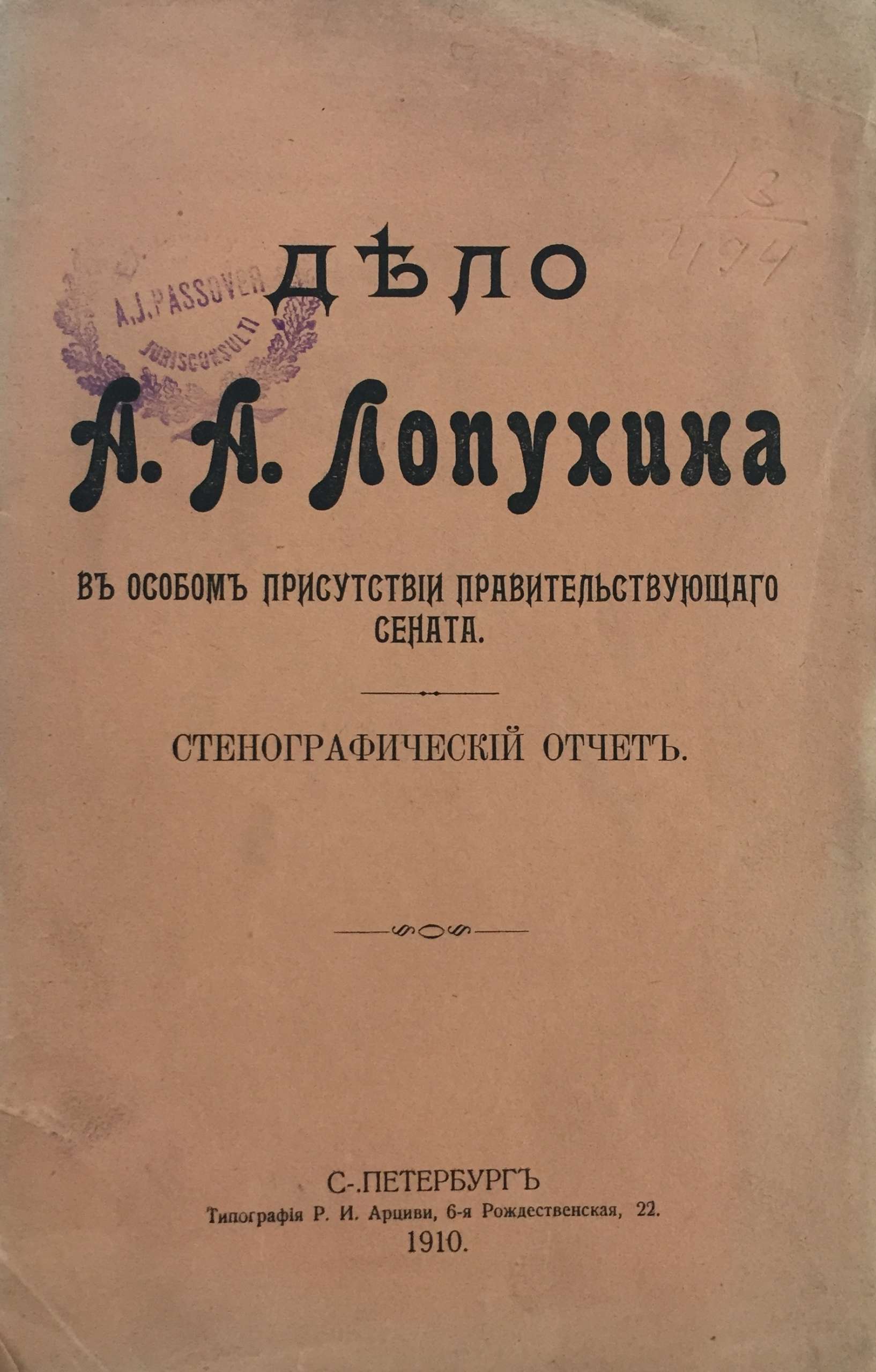
Дело А. А. Лопухина в особом присутствии правительствующего сената. Стенографический отчет. С.-Петербург, типография Р. И. Арциви, 1910. С.116. Из библиотеки А. Я. Пассовера.
Суд проходил в марте 1909 года. Бывший директор департамента полиции А. А. Лопухин обвиняется в том, что выдал провокатора Е. Ф. Азефа партии социалистов-революционеров. А. Я. Пассовер защищал Лопухина на этом суде. Суд присудил Лопухина (1 мая 1909 г.) к 5 годам каторжных работ с лишением всех прав состояния. Решением Общего собрания кассационных департаментов правительствующего сената, в виду смягчающих вину обстоятельств, каторга была заменена ссылкой на поселение.
-
 Iron tsuba of round form with design of diamond-shaped family crest (waribishi-mon) in openwork (sukashi). Bevelled, raised rim. Kozuka-hitsu-ana plugged with tin or lead. Ko-Katchushi school. Early Muromachi period: Early 15th century (Oei era). Size: Height: 89.3 mm. Width: 89.0 mm. Rim thickness: 4.3 mm. Center thickness: 2.9 mm. Provenance: Sasano Masayuki Collection, № 41: "In this tsuba, a family crest incorporating four lozenges sits upright on the right side of the nakago-ana. The straight lines of the lozenge add substance and power. Initially, the crest creates confusion regarding the age, yet the overall impression is one lacking in vigor and probably dates rather later than Nanbokucho period".
Iron tsuba of round form with design of diamond-shaped family crest (waribishi-mon) in openwork (sukashi). Bevelled, raised rim. Kozuka-hitsu-ana plugged with tin or lead. Ko-Katchushi school. Early Muromachi period: Early 15th century (Oei era). Size: Height: 89.3 mm. Width: 89.0 mm. Rim thickness: 4.3 mm. Center thickness: 2.9 mm. Provenance: Sasano Masayuki Collection, № 41: "In this tsuba, a family crest incorporating four lozenges sits upright on the right side of the nakago-ana. The straight lines of the lozenge add substance and power. Initially, the crest creates confusion regarding the age, yet the overall impression is one lacking in vigor and probably dates rather later than Nanbokucho period". -
 The thin, four-lobed iron plate of brownish color is carved on each side with two concentric grooves in the middle of the web, and with four thin scroll lines (handles, kan) that follow the shape of the rim. The hitsu-ana were added at a later date. Copper sekigane. Kamakura-bori school. Muromachi period, circa 1400-1550. Size: Height 80.4 mm, width 79.0 mm, thickness 3.2 mm at seppa-dai and 2.7 mm at the rim. Weight: 97.7 g. NBTHK Certificate №4004241: 'Hozon' attestation. As for the motif: the concentric circles is a widespread and generic design. It is described by John W. Dower [The Elements of Japanese Design, 1985, p. 132, #2201-30] as follows: Circle: Enclosure (wa). As a crest by itself, the cirlce carries obvious connotations of perfection, harmony, completeness, integrity, even peace. [...] Ordinary circles are labeled according to their thickness, with terminology ranging from hairline to "snake's eye". The motif that is described by both Compton Collection and R.E. Haynes as "scrolls", presented by John W. Dower as "Handle (kan): Although probably a purely ornamental and nonrepresentational design in origin, over the centuries this motif acquired the label kan, denoting its resemblance to the metal handles traditionally used on chests of drawers. [...] Very possibly the "handle" motif represents an early abstract version of the popular mokko, or melon pattern." Early Chinese Taoists claimed that special melon was associated with the Eastern Paradise of Mount Horai just as life-giving peaches were associated with the Western Paradise of the Kunlun Mountains. [...] A design motif called mokko (also translated as "melon" in accordance with the two ideographs with which it is written) may have nothing to do with the fruit. Mokko designs... are widely used as crests of both private families and Shinto shrines and are repeated as background designs that evoke a sense of classicism" [Symbols of Japan. Merrily Baird, 2001]. There is a look alike tsuba at Dr. Walter A. Compton Collection, 1992, Christie’s auction, Part II, pp. 14-15, №16:
The thin, four-lobed iron plate of brownish color is carved on each side with two concentric grooves in the middle of the web, and with four thin scroll lines (handles, kan) that follow the shape of the rim. The hitsu-ana were added at a later date. Copper sekigane. Kamakura-bori school. Muromachi period, circa 1400-1550. Size: Height 80.4 mm, width 79.0 mm, thickness 3.2 mm at seppa-dai and 2.7 mm at the rim. Weight: 97.7 g. NBTHK Certificate №4004241: 'Hozon' attestation. As for the motif: the concentric circles is a widespread and generic design. It is described by John W. Dower [The Elements of Japanese Design, 1985, p. 132, #2201-30] as follows: Circle: Enclosure (wa). As a crest by itself, the cirlce carries obvious connotations of perfection, harmony, completeness, integrity, even peace. [...] Ordinary circles are labeled according to their thickness, with terminology ranging from hairline to "snake's eye". The motif that is described by both Compton Collection and R.E. Haynes as "scrolls", presented by John W. Dower as "Handle (kan): Although probably a purely ornamental and nonrepresentational design in origin, over the centuries this motif acquired the label kan, denoting its resemblance to the metal handles traditionally used on chests of drawers. [...] Very possibly the "handle" motif represents an early abstract version of the popular mokko, or melon pattern." Early Chinese Taoists claimed that special melon was associated with the Eastern Paradise of Mount Horai just as life-giving peaches were associated with the Western Paradise of the Kunlun Mountains. [...] A design motif called mokko (also translated as "melon" in accordance with the two ideographs with which it is written) may have nothing to do with the fruit. Mokko designs... are widely used as crests of both private families and Shinto shrines and are repeated as background designs that evoke a sense of classicism" [Symbols of Japan. Merrily Baird, 2001]. There is a look alike tsuba at Dr. Walter A. Compton Collection, 1992, Christie’s auction, Part II, pp. 14-15, №16: The description goes: “A kamakurabori type tsuba, Muromachi period, circa 1400. The thin, six-lobed iron plate is carved on each side with a wide groove that follows the shape of the rim, and with six scroll lines and a single thin circular groove. […] The hitsu-ana was added at a later date, circa 1500-1550. Height 8.3 cm, width 8.6 cm, thickness 2.5 mm. The tsuba was initially intended to be mounted on a tachi of the battle type in use from Nambokucho to early Muromachi period (1333-1400)”. Sold at $935.
And another one in Robert E. Haynes Catalog #9 on page 24-25 under №23:
The description goes: “A kamakurabori type tsuba, Muromachi period, circa 1400. The thin, six-lobed iron plate is carved on each side with a wide groove that follows the shape of the rim, and with six scroll lines and a single thin circular groove. […] The hitsu-ana was added at a later date, circa 1500-1550. Height 8.3 cm, width 8.6 cm, thickness 2.5 mm. The tsuba was initially intended to be mounted on a tachi of the battle type in use from Nambokucho to early Muromachi period (1333-1400)”. Sold at $935.
And another one in Robert E. Haynes Catalog #9 on page 24-25 under №23:
 R.E. Haynes description: “Typical later Kamakura-bori style work. This type of plate and carving show the uniform work produced by several schools in the Muromachi period. Some had brass inlay and others were just carved as this one is. The hitsu are later. Ca. 1550. Ht. 8.8 cm, Th. 3.25 mm”. Sold for $175.
R.E. Haynes description: “Typical later Kamakura-bori style work. This type of plate and carving show the uniform work produced by several schools in the Muromachi period. Some had brass inlay and others were just carved as this one is. The hitsu are later. Ca. 1550. Ht. 8.8 cm, Th. 3.25 mm”. Sold for $175.
-
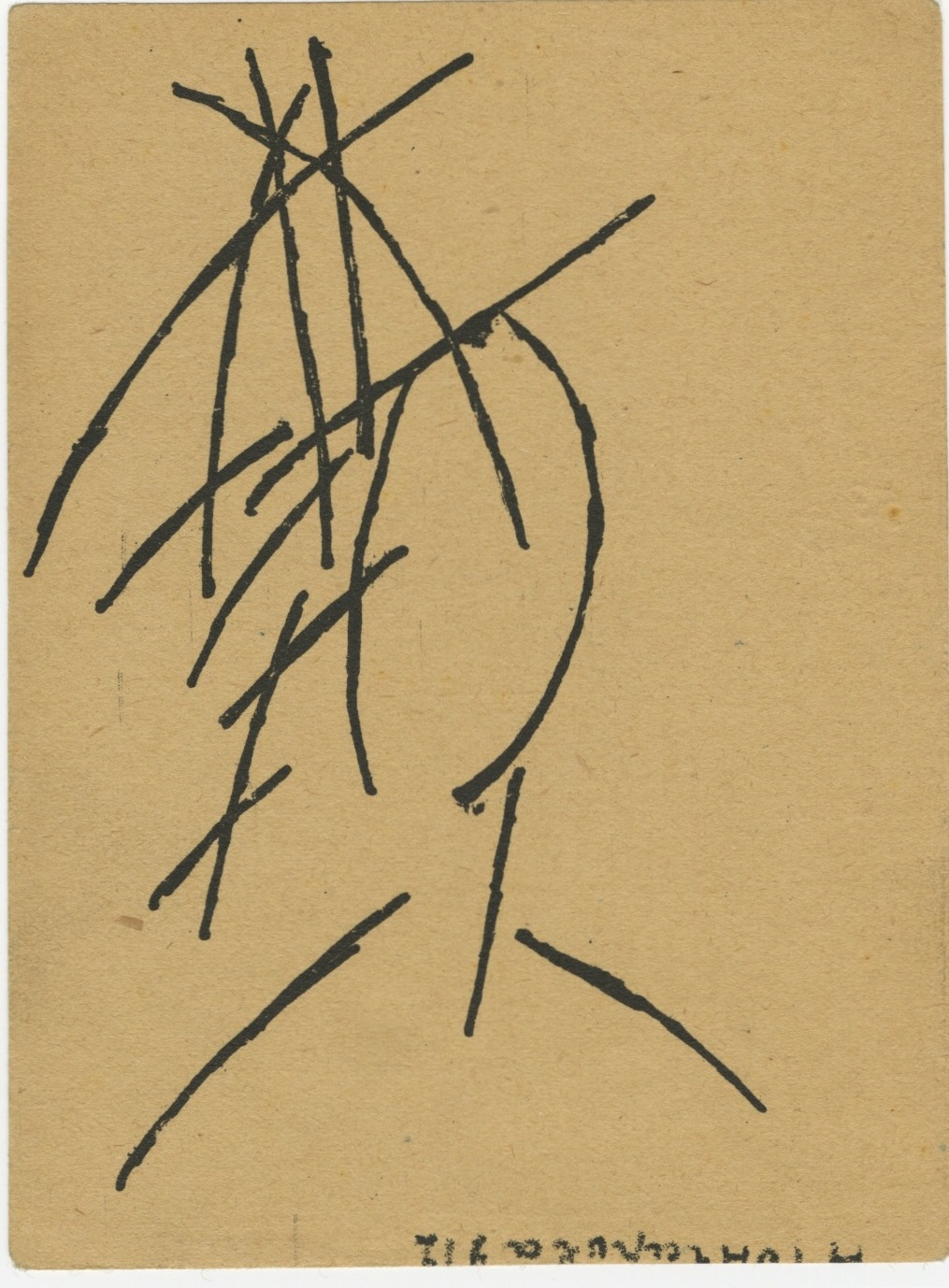 Artist: Mikhail Larionov (June 3, 1881 – May 10, 1964) ). Russian/French. Lithographic illustration "Woman in a hat" for Aleksei Kruchenykh book "Lipstick", Moscow, Kuzmin and Dolinsky Publishers, 1913, 480 copies printed. Size: 11,3 х 8,2 cm. Михаил Ларионов (3 июня 1881 – 10 мая 1964). Россия/Франция. Литографическая иллюстрация "Женщина в шляпе" к книге Алексея Крученых "Помада"; М.: Изд. Г.Л. Кузьмина и С.Д. Долинского, 1913, отпечатана в 480 экз. Формат: 11,3 х 8,2 см.
Artist: Mikhail Larionov (June 3, 1881 – May 10, 1964) ). Russian/French. Lithographic illustration "Woman in a hat" for Aleksei Kruchenykh book "Lipstick", Moscow, Kuzmin and Dolinsky Publishers, 1913, 480 copies printed. Size: 11,3 х 8,2 cm. Михаил Ларионов (3 июня 1881 – 10 мая 1964). Россия/Франция. Литографическая иллюстрация "Женщина в шляпе" к книге Алексея Крученых "Помада"; М.: Изд. Г.Л. Кузьмина и С.Д. Долинского, 1913, отпечатана в 480 экз. Формат: 11,3 х 8,2 см. -
 An iron tsuba of round shape inlaid with shakudō, gold, and silver with a motif of a weather-beaten (nozarashi) skull and grasses growing beside as well as through the eye-pit, and a crescent moon above the scene. Grasses on the reverse. Unsigned. Dimensions: 71.7 x 70.6 x 4.2 mm Reference: Skull, bones and grave markers SOLD
An iron tsuba of round shape inlaid with shakudō, gold, and silver with a motif of a weather-beaten (nozarashi) skull and grasses growing beside as well as through the eye-pit, and a crescent moon above the scene. Grasses on the reverse. Unsigned. Dimensions: 71.7 x 70.6 x 4.2 mm Reference: Skull, bones and grave markers SOLD -

Iron tsuba of round form decorated with a design of bracken scrolls and paulownia leaves and blossoms (kiri-mon) in openwork (sukashi). Details carved in kebori. Squared rim with iron bones (tekkotsu). Hitsu-ana plugged with shakudō.
Size: 83.6 x 82.9 x 5.4 (center), 5.1 (rim) mm.
Unsigned.
Muromachi period, ca. 16th century.


